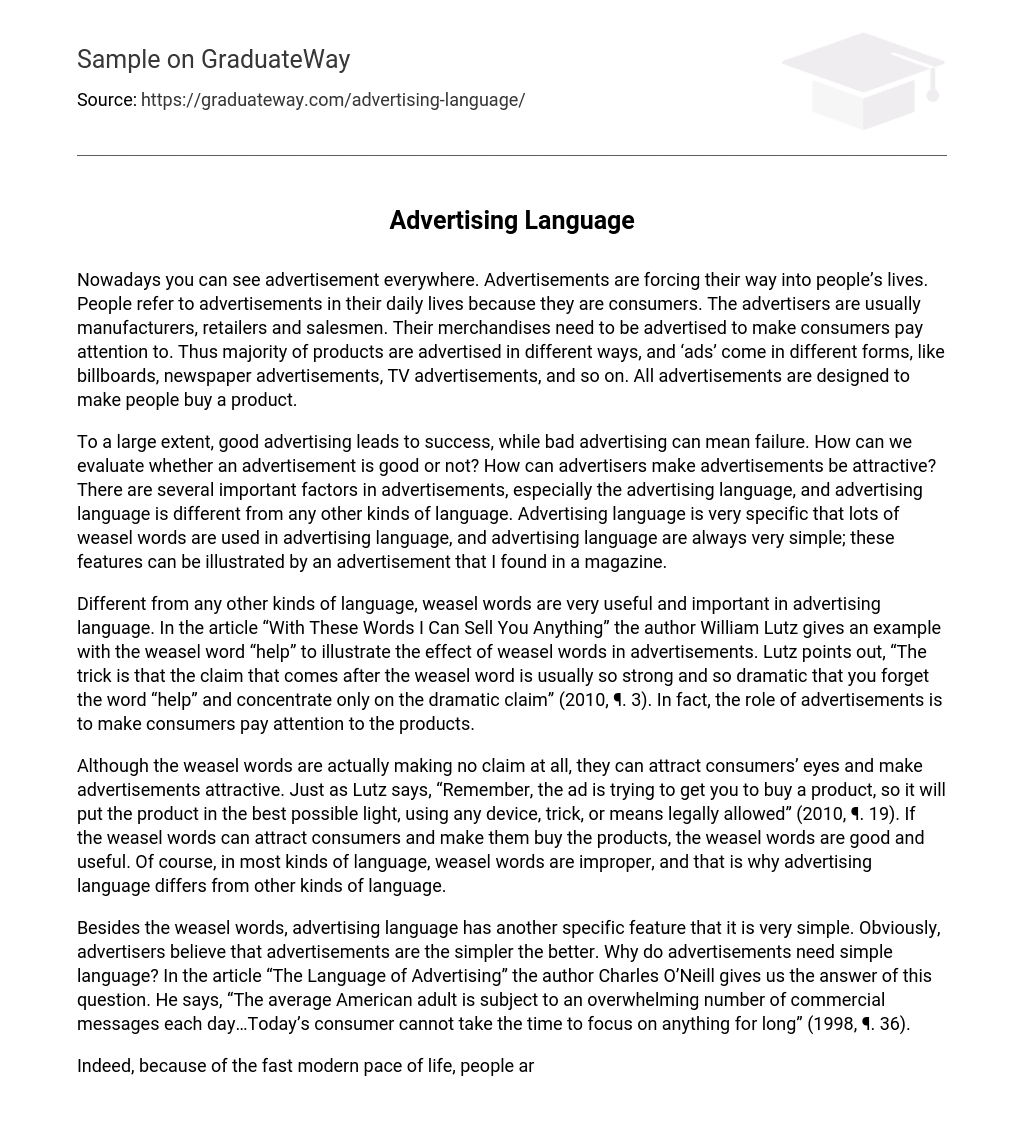Advertising has become widespread and intrusive in today’s society, constantly popping up during people’s daily routines. Manufacturers, retailers, and salespeople heavily depend on advertising to attract consumers’ interest in their products. This is why billboards, newspaper ads, TV commercials, and various other mediums are used to promote a diverse array of goods. Ultimately, the main objective of all advertisements is to motivate individuals to buy.
The impact of advertising on success or failure is significant. Advertisers must evaluate and create appealing advertisements, facing the challenge of using effective advertising language. This language often includes weasel words and is simplistic in nature. I found an example of this in a magazine advertisement.
Weasel words, which are unique to advertising language, are incredibly useful and important. In his article “With These Words I Can Sell You Anything,” William Lutz provides an example using the weasel word “help” to demonstrate the impact of these words in advertisements. Lutz explains that the clever aspect lies in the fact that the subsequent claim following the weasel word is often so powerful and captivating that consumers overlook the word “help” and focus solely on the sensational claim (2010, ¶. 3). Ultimately, advertisements strive to grab consumers’ attention towards the products being promoted.
Although weasel words serve no actual claim, they have the ability to catch the attention of consumers and make advertisements appealing. As stated by Lutz (2010, ¶. 19), “Remember, the ad is trying to get you to buy a product, so it will put the product in the best possible light, using any device, trick, or means legally allowed.” If weasel words are effective in attracting consumers and driving their purchases, then they can be considered advantageous and valuable. Naturally, in most forms of communication, weasel words are considered inappropriate, which is why advertising language diverges from other forms of language.
In addition to the use of vague language, the language used in advertising is distinctively straightforward. Advertisers believe that simplicity is key in advertising. The reason for this is explained by Charles O’Neill in his article “The Language of Advertising”. According to O’Neill, the average American adult is bombarded with a large number of advertisements every day. As a result, today’s consumer does not have the luxury of focusing on any one thing for an extended period of time (1998, ¶. 36).
Due to the fast pace of modern life, people are too busy to spend time reading lengthy advertisements. Additionally, using simple words makes it easier for individuals to remember and comprehend the message. O’Neill supports this argument in his article, stating that complex words or images are removed and replaced with straightforward ones that cannot be misinterpreted. One does not need to be highly educated to understand these simplified advertisements (O’Neill, 1998, ¶. 37). Ultimately, using easily understandable language is crucial in advertising.
For example, one of Haagen-Dazs’ advertisements states, “Love her, love Haagen-Dazs.” Despite its simplicity of just four words, the intention of this ad is clear – to convey that Haagen-Dazs is excellent and deserving of love. The simplicity of this advertisement enables quick comprehension and recollection. It makes us wonder how advertisements can capture the attention of consumers and persuade them to make purchases if they fail to understand the message.
When it comes to advertising, simplicity is essential as it embodies a fundamental aspect. To illustrate this point, we will examine an actual magazine ad promoting a seafood restaurant. The target audience for this advertisement consists of people who appreciate or have a fondness for seafood. Within the ad, one can observe the utilization of weasel words like “the freshest seafood” and “the finest view.”
To entice customers, advertisers frequently employ terms like “freshest” and “finest” to promote restaurants. Nevertheless, there is ambiguity surrounding the true meaning of these terms and how advertisers can guarantee that their products meet such criteria. Despite this uncertainty, the utilization of these enticing words proves successful in attracting consumers. Additionally, the minimalist strategy with limited wording contributes to the advertisement’s triumph.
Advertising language has a distinct goal of capturing consumers’ attention and making a lasting impression quickly. This is achieved by utilizing weasel words and straightforward language, as evident in the advertisement. Therefore, regardless of the advertising format employed, these two elements are crucial for attracting consumers and highlighting the unique qualities of advertising language.
Reference
Lutz, W. (2010). “With these words I can persuade you to purchase anything.” In G. Goshgarian, “What matters in America” (pp. 114-120). O’Neill, C. A. (2006). “The language of Advertising.” In G. Goshgarian, “Exploring language” (pp. 124-130).





